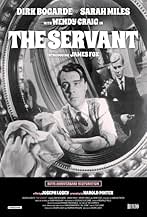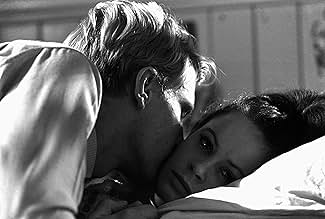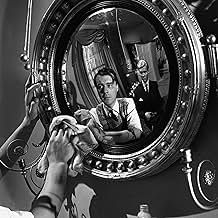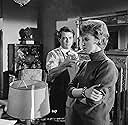IMDb रेटिंग
7.8/10
15 हज़ार
आपकी रेटिंग
अपनी भाषा में प्लॉट जोड़ेंUpper-class Tony hires servant Hugo Barrett, who turns out to have a hidden agenda.Upper-class Tony hires servant Hugo Barrett, who turns out to have a hidden agenda.Upper-class Tony hires servant Hugo Barrett, who turns out to have a hidden agenda.
- 3 BAFTA अवार्ड जीते गए
- 8 जीत और कुल 11 नामांकन
Doris Nolan
- People in restaurant: Older Woman
- (as Doris Knox)
फ़ीचर्ड समीक्षाएं
The Servant is directed by Joseph Losey and adapted to screenplay by Harold Pinter from the novelette of the same name written by Robin Maugham. It stars Dirk Bogarde, Sarah Mles, Wendy Craig and James Fox. Music is by John Dankworth and cinematography by Douglas Slocombe.
When well-to-do Londoner Tony (Fox) hires Hugo Barrett (Bogarde) as his manservant, he gets more than he bargained for. Especially when Hugo's sister Vera (Miles) also arrives on the scene
The Servant remains as enigmatic today as it was back on its release in the early part of the 1960s. It's a film that defies classification, that rare old cinematic treat that continues to cause debate about not only its worth as art, but also its very meaning(s). A head bothering delight that revels in toying with your perceptions as much as Hugo Barrett enjoys toying with his supposed master. Lets play master and servant - indeed.
Set predominantly in the confines of Tony's swanky Chelsea abode, there's a disturbing claustrophobia that pervades the narrative, and this before we even begin to ponder the power of man, his ability to dominate and manipulate, or the reverse side that sees another's lack of ability to not succumb to the downward spiral instigated by a supposed lesser man.
Sprinkled over power issues are sexual desires, obtained, unfulfilled or simmering away unspoken. As the literate screenplay comes out in sharp dialogue snatches, breaking free of Pinter's other wise cement ensconced writing, there's evidence that this is a psychological study as opposed to the class system allegory that many thought it was way back then. This really isn't about role reversal, the finale tells us that.
Visually it's a box of atmospheric tricks as well. Losey and Slocombe use deep angular black and white photography to enforce the chilly dynamics at work in the story, the longer the film goes on, as it gets to the nitty gritty, the more jarring the camera work becomes – delightfully so – the house no longer an affluent person's residence, but a skew-whiff place of debauchery and mind transference. And mirrors - reflections, important and used to great effect.
Some scenes are striking and rich. Hugo at the top of the stairs standing in the bedroom doorway, in silhouette, an overhead shot of Hugo and Tony playing a childlike ball game on the stairs, a sex scene on a leather chair that we don't see but understand totally. And many more as Losey finds the material that allows him to show his skills.
Cast performances are across the board terrific, particularly Bogarde who gives a visual acting master class, and Fox who beautifully shifts a gear from toff twit into dependant dead beat. While Dankworth's musical accompaniments add flavour to the unfolding machinations. 9/10
When well-to-do Londoner Tony (Fox) hires Hugo Barrett (Bogarde) as his manservant, he gets more than he bargained for. Especially when Hugo's sister Vera (Miles) also arrives on the scene
The Servant remains as enigmatic today as it was back on its release in the early part of the 1960s. It's a film that defies classification, that rare old cinematic treat that continues to cause debate about not only its worth as art, but also its very meaning(s). A head bothering delight that revels in toying with your perceptions as much as Hugo Barrett enjoys toying with his supposed master. Lets play master and servant - indeed.
Set predominantly in the confines of Tony's swanky Chelsea abode, there's a disturbing claustrophobia that pervades the narrative, and this before we even begin to ponder the power of man, his ability to dominate and manipulate, or the reverse side that sees another's lack of ability to not succumb to the downward spiral instigated by a supposed lesser man.
Sprinkled over power issues are sexual desires, obtained, unfulfilled or simmering away unspoken. As the literate screenplay comes out in sharp dialogue snatches, breaking free of Pinter's other wise cement ensconced writing, there's evidence that this is a psychological study as opposed to the class system allegory that many thought it was way back then. This really isn't about role reversal, the finale tells us that.
Visually it's a box of atmospheric tricks as well. Losey and Slocombe use deep angular black and white photography to enforce the chilly dynamics at work in the story, the longer the film goes on, as it gets to the nitty gritty, the more jarring the camera work becomes – delightfully so – the house no longer an affluent person's residence, but a skew-whiff place of debauchery and mind transference. And mirrors - reflections, important and used to great effect.
Some scenes are striking and rich. Hugo at the top of the stairs standing in the bedroom doorway, in silhouette, an overhead shot of Hugo and Tony playing a childlike ball game on the stairs, a sex scene on a leather chair that we don't see but understand totally. And many more as Losey finds the material that allows him to show his skills.
Cast performances are across the board terrific, particularly Bogarde who gives a visual acting master class, and Fox who beautifully shifts a gear from toff twit into dependant dead beat. While Dankworth's musical accompaniments add flavour to the unfolding machinations. 9/10
"The Servant" was a film I had to think a lot about. Though I would not consider it as being flawless, it is a very interesting and indeed memorable piece of British cinema.
The characters itself could have been taken from P. G. Wodehouse's hilarious series of comic novels about the perfect butler Jeeves and his 'master' 'Bertie' Wooster, a young, superficial, and careless dandy who could not make one step without Jeeves constantly caring for him.
In "The Servant", a similar relationship is twisted in a much darker way: Hugo Barrett is not at all the faithful servant devoted to his master - though he appears to be at the beginning -, but a scheming, quite evil person who knows very well what he wants. (Though the real motives of his deeds do not become completely clear in the story - but this makes him probably even scarier.)
Dirk Bogarde was just wonderful. Most impressive. His body language, shifting from servile to casual, menacing or frivolous is meticulously developed and executed. The supporting actors were also good, notably James Fox. Sarah Miles tried everything to bring life to her rather cartoonish character, though she never could make me understand how Tony could be so sexually attracted to a woman like her in the first place.
I loved the homoerotic undertones of the Barrett-Tony relationship, especially in the second half of the film, after Barrett's return. They two men often act like a (gay) couple, especially in their disputes. There is also a great piece of dialogue between the two, written in tongue-in-cheek manner by Pinter, when they talk about feeling being "pals" and mention that they have felt like that "in the army before". The loveliest scene was the one where Barrett tells Tony that his "old flame" (Susan) has arrived and then says in a flirtatious manner "one yesterday - and one tonight" while holding Tony's face in his hand. We don't know yet at this point that he has invited some prostitutes, so this remark seems quite ambigous for a moment...
The symbolism is great, the many mirrors in the film forming a substitute for Barrett's gaze, never leaving Tony and Susan. There is also some phallic symbolism (most openly in the long shot of the garden just after the scene when Vera arrives at Tony's house). And Douglas Slocombe's black-and-white photography is just about incredible.
What I liked less about the film was that it was a weird mixture of what is basically a 19th century morality tale, but set in the 1960s and shot in the manner of the 1930s (the latter being no problem at all, but rather increasing the value of the film). The scenes with the women, especially the "erotic" scenes, were also rather awkward and very Sixties in style, so many of them seemed quite out of date, viewed today. The morality of the story was also quite flat in my opinion, and I must admit that I didn't care too much for Tony, this lazy and not very intelligent rich young dandy. In fact, I rather enjoyed Barrett catching the fly in his web...
The characters itself could have been taken from P. G. Wodehouse's hilarious series of comic novels about the perfect butler Jeeves and his 'master' 'Bertie' Wooster, a young, superficial, and careless dandy who could not make one step without Jeeves constantly caring for him.
In "The Servant", a similar relationship is twisted in a much darker way: Hugo Barrett is not at all the faithful servant devoted to his master - though he appears to be at the beginning -, but a scheming, quite evil person who knows very well what he wants. (Though the real motives of his deeds do not become completely clear in the story - but this makes him probably even scarier.)
Dirk Bogarde was just wonderful. Most impressive. His body language, shifting from servile to casual, menacing or frivolous is meticulously developed and executed. The supporting actors were also good, notably James Fox. Sarah Miles tried everything to bring life to her rather cartoonish character, though she never could make me understand how Tony could be so sexually attracted to a woman like her in the first place.
I loved the homoerotic undertones of the Barrett-Tony relationship, especially in the second half of the film, after Barrett's return. They two men often act like a (gay) couple, especially in their disputes. There is also a great piece of dialogue between the two, written in tongue-in-cheek manner by Pinter, when they talk about feeling being "pals" and mention that they have felt like that "in the army before". The loveliest scene was the one where Barrett tells Tony that his "old flame" (Susan) has arrived and then says in a flirtatious manner "one yesterday - and one tonight" while holding Tony's face in his hand. We don't know yet at this point that he has invited some prostitutes, so this remark seems quite ambigous for a moment...
The symbolism is great, the many mirrors in the film forming a substitute for Barrett's gaze, never leaving Tony and Susan. There is also some phallic symbolism (most openly in the long shot of the garden just after the scene when Vera arrives at Tony's house). And Douglas Slocombe's black-and-white photography is just about incredible.
What I liked less about the film was that it was a weird mixture of what is basically a 19th century morality tale, but set in the 1960s and shot in the manner of the 1930s (the latter being no problem at all, but rather increasing the value of the film). The scenes with the women, especially the "erotic" scenes, were also rather awkward and very Sixties in style, so many of them seemed quite out of date, viewed today. The morality of the story was also quite flat in my opinion, and I must admit that I didn't care too much for Tony, this lazy and not very intelligent rich young dandy. In fact, I rather enjoyed Barrett catching the fly in his web...
If you watch closely you will find that not only does the internal decoration of the house change (in ways not included in the plot) to become gradually darker as Tony is gradually undermined and seduced by Barrett but also the excellent (but very much of its time) soundtrack by Johnny Dankworth & (surely - or is my recollection wrong?) Cleo Laine - though the same LP is put on the turntable many times, the arrangement of the same theme is different. (I did not notice this at first but found it pointed out in a special issue of the Oxford University magazine Isis at the time the film was released that was entirely devoted to it.) The film has recently reappeared in England as a stage work: Play without Words, seen at the National Theatre, is (was, I guess, is more accurate) a superb piece of dance theatre in which the ambiguities of the characters' motivations, or the discrepancies between their thoughts and actions, are portrayed by having more than one dancer per character. Sometimes only one is seen, sometimes they move in unison, sometimes in separate ways. It is extremely effective.
About midpoint Tony's girlfriend Susan asks servant Hugo, "What do you want from this house?" It's a direct and pointed question that's ambiguously answered ("I'm just the servant, mum.")
That ambiguity carries the dramatic tension along its murky but intriguing path, as a strange play of power and manipulation unfolds. Yet after a series of quirkly developments transpire and the tables of manservant and master are reversed, what's the real gain?
What was there in the house in the first place that was worth all the fuss and bother to acquire? Satisfaction of taking over the master role?
Whatever the goal, it all seems a tawdry victory. After the shoe's on the other foot and a few points are scored in this cheesy power game, where's the spoil?
What does drive this drama is Pinter's genius for inventing small talk that gives the illusion of grandeur Losey's direction is right on the mark, and the production design, score, photography--and the acting--are all top drawer.
As in his subversive play, "The Homecoming," Pinter manages to hold the attention with his unique pregnant pauses and hypnotic ambiance, which are actually illusionary. It could be a play about something very important or about nothing.
One thing is for certain: once "The Servant" is seen, one never quite forgets it.
This remains Dirk Bogarde's defining cinematic role.
That ambiguity carries the dramatic tension along its murky but intriguing path, as a strange play of power and manipulation unfolds. Yet after a series of quirkly developments transpire and the tables of manservant and master are reversed, what's the real gain?
What was there in the house in the first place that was worth all the fuss and bother to acquire? Satisfaction of taking over the master role?
Whatever the goal, it all seems a tawdry victory. After the shoe's on the other foot and a few points are scored in this cheesy power game, where's the spoil?
What does drive this drama is Pinter's genius for inventing small talk that gives the illusion of grandeur Losey's direction is right on the mark, and the production design, score, photography--and the acting--are all top drawer.
As in his subversive play, "The Homecoming," Pinter manages to hold the attention with his unique pregnant pauses and hypnotic ambiance, which are actually illusionary. It could be a play about something very important or about nothing.
One thing is for certain: once "The Servant" is seen, one never quite forgets it.
This remains Dirk Bogarde's defining cinematic role.
This is a superb, sinister movie of the very highest class. Unlike the character Tony (James Fox) who is upper class without being high class, if you get my drift. You cannot really sympathise with Tony, who toys with some high falutin' development projects but basically is a wastrel just waiting to be ponced off. Tony is a later-day Bertie Wooster. The sinister element comes from the servant (Dirk Bogarde), who is no Jeeves. Barrett, like Jeeves , is a gentleman's gentleman or valet (not a butler as suggested in some other comments on this film). Tony needs a valet because he is incapable of doing anything much without help. Barrett and his accomplice Vera (Sarah Miles) take Tony to the cleaners, sweeping aside the fiancee Susan (Wendy Craig) in their wake.
Harold Pinter has written the screenplay in similar vein to the superb movie The Accident, also a Losey piece, which I also commend. The cinematography in both movies is simply excellent. The subject matter of The Servant suits Pinter, although much of the screenplay is not really in Pinter's voice. However, there is one scene, set in a restaurant, which includes a tiny cameo by Pinter himself and which contains a short Pinteresque exchange between two women. There is also one tense exchange between Susan and Barrett "do you wear deodorant" etc. which is very reminiscent of a scene in The Caretaker "you stink from arsehole to Thursday" etc. Indeed the story of The Servant resembles The Caretaker in many respects, except that in The Servant the interloper, Barrett, is on top and stays there, whereas in The Caretaker the interloper, Davies, lacks the skill and circumstances to dislodge the incumbent.
There is a homoerotic undercurrent to the film and this works so well because it is an undercurrent (in 1963 there could have been no more than an undercurrent even if they had wanted more). The overt debauchery with Vera and the orgy party towards the end of the film is the only bit of the film that has aged without grace. But I quibble.
This is a truly great film and it deserves to be more widely known.
Harold Pinter has written the screenplay in similar vein to the superb movie The Accident, also a Losey piece, which I also commend. The cinematography in both movies is simply excellent. The subject matter of The Servant suits Pinter, although much of the screenplay is not really in Pinter's voice. However, there is one scene, set in a restaurant, which includes a tiny cameo by Pinter himself and which contains a short Pinteresque exchange between two women. There is also one tense exchange between Susan and Barrett "do you wear deodorant" etc. which is very reminiscent of a scene in The Caretaker "you stink from arsehole to Thursday" etc. Indeed the story of The Servant resembles The Caretaker in many respects, except that in The Servant the interloper, Barrett, is on top and stays there, whereas in The Caretaker the interloper, Davies, lacks the skill and circumstances to dislodge the incumbent.
There is a homoerotic undercurrent to the film and this works so well because it is an undercurrent (in 1963 there could have been no more than an undercurrent even if they had wanted more). The overt debauchery with Vera and the orgy party towards the end of the film is the only bit of the film that has aged without grace. But I quibble.
This is a truly great film and it deserves to be more widely known.
क्या आपको पता है
- ट्रिवियाWhen producer and director Joseph Losey was hospitalized with a brutal case of pneumonia for two weeks during this shoot, Dirk Bogarde continued filming assisted by minute, daily instructions over the phone from Losey's hospital bed. When Losey returned to the set, he did not re-shoot any of the script, much to the relief of cast and crew. Bogarde managed to keep the film on schedule, though he later said the experience made him determined never to direct.
- गूफ़When Tony and Susan arrive at Tony's house in the Mercedes, with an extended visit in mind, they both go into the house and Tony leaves the car's lights on.
- भाव
Hugo Barrett: I'll tell you what I am. I'm a gentleman's gentleman, and you're no bloody GENTLEMAN!
टॉप पसंद
रेटिंग देने के लिए साइन-इन करें और वैयक्तिकृत सुझावों के लिए वॉचलिस्ट करें
- How long is The Servant?Alexa द्वारा संचालित
विवरण
बॉक्स ऑफ़िस
- US और कनाडा में सकल
- $45,522
- US और कनाडा में पहले सप्ताह में कुल कमाई
- $7,859
- 28 जुल॰ 2013
- दुनिया भर में सकल
- $76,892
- चलने की अवधि
- 1 घं 56 मि(116 min)
- रंग
- पक्ष अनुपात
- 1.66 : 1
इस पेज में योगदान दें
किसी बदलाव का सुझाव दें या अनुपलब्ध कॉन्टेंट जोड़ें


































